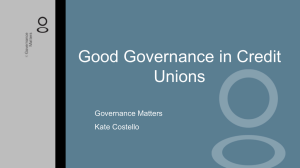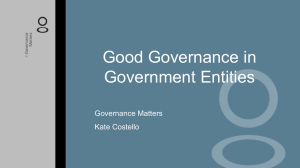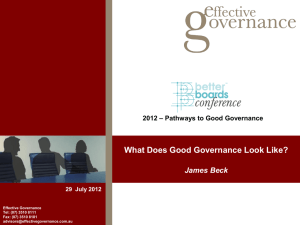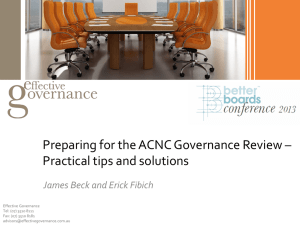Good Governance in Sports` Organisations Powerpoint pp1000024
advertisement
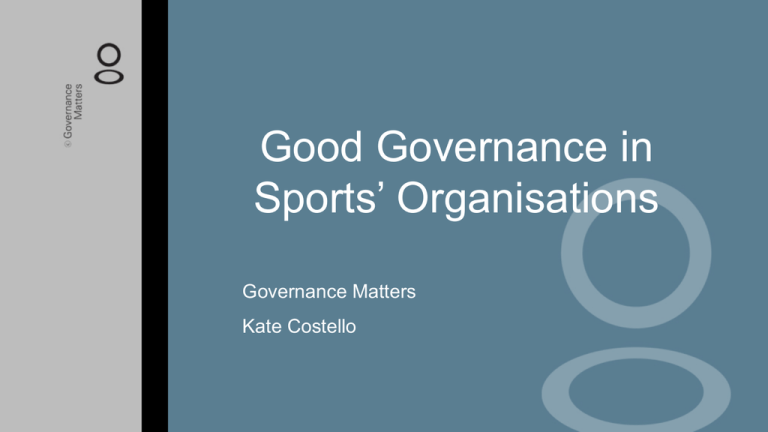
Good Governance in Sports’ Organisations Governance Matters Kate Costello Effective Governance • understand the role of the Board • get the right skills and encourage the right behaviour • introduce effective processes Understand the Role of the Board Governance is what the Board does or should do to be a “value-adder” to the organisation rather than just a “costcentre”. It is different from what management does or should do. What is Governance? “The Board’s role is to create the future of the organisation, not just mind the shop”. John Carver The Role of the Board Outward Looking Compliance Roles Inward Looking Strategy Formulation Accountability Appoint CEO Monitoring and Supervision Past & Present Performance Roles Policy Making Future *adapted from Tricker, RI: International Corporate Governance (1994) p149 Accountability Those you can’t say no to! • • • • the law and regulation constituent document or empowering legislation creditors (eg. bank; suppliers) other contractors (eg government funding; sponsors) Accountability Those you need to listen to! • owners (shareholders; members; government) • customers • staff • the community Good Governance in Accountability • “listening” to stakeholders • risk management • organisational culture Strategy Formulation • what is “Strategy”? – Michael Porter • the gut, the head, the heart • answer the hard questions Good Governance in Strategy • longer term strategic plan (with measures) • aligned operational/business/annual plan (with measures) • aligned budgets Good Governance in Strategy • dedicate some board meetings to strategic matters • spend the first hour on a strategic issue • reorganise the agenda (decision; discussion; noting) Policy “I define policy as the value or perspective that underlies action. Of course that means everyone in the organisation makes policy including staff members, but boards must make the broadest and most inclusive policies in order to control the organisation. The trick is for the board to make distinctions between the types and sizes of policy, so that what is delegated is clear”. Carver J: Reinventing Your Board, P41 Good Governance in Policy Carver argues that the board only has one employee, the CEO. “The board will: • instruct only the CEO • view all organisational performance as that of the CEO • view any organisational failure to comply with board policy as the failure of the CEO • require that the CEO keep the organisational performance within policy criteria and restore it to this state should there be policy violations • never in its official capacity, help the CEO manage” John Carver Good Governance in Policy • • • Matters reserved for the board Policy separated from minutes Board Manual Monitoring and Supervision • • • • By strategic KPIs By annual KPIs By compliance with board policy By agreeing what information will come to the board, in what format CEO and Succession • • • • “hire and fire” the CEO remunerate and reward assess performance plan for succession Get the Right Skills • size of the board • board skill set • committees the right ones? clear terms of reference? reviewed, or task forces? • amend constituent document Board Member Knowledge • • induction management update sessions • expert reports • expert development sessions • Board and director performance evaluation Encourage the Right Behaviour Board Effectiveness Research Shey Newitt Compliant but not contributing: why Australian boards are being underutilised Working Relationships • • • Chair – CEO relationship critical behaviour and teamwork a “living” Code of Conduct Introduce Effective Processes • • • • • calendar papers before meeting clear, concise, precise papers duration of meetings calibre of minutes plus action list • receipt of minutes after meeting Effective Governance • understand the role of the Board • get the right skills and encourage the right behaviour • introduce effective processes Good Governance in Sports’ Organisations Constitution/Rules • company limited by guarantee if NSO • governance function with board (not split with a council) • constitution/rules flexible allowing changing policy or bylaws Accountability • communication with primary stakeholders • compliance policies covering legal, financial and operational risks • “representative” board members and a code of conduct covering conflicts Strategy • aligned Objects across Australia • clear strategic direction for the sport Australia-wide • board spends enough time on strategic issues Policy • board meddling in operations • board policies easy to access • policies reviewed regularly CEO/GM • performance management • succession planning Structure • • • • size of board the right skills and diversity terms of board members committees reviewed Teamwork • chair manages behaviour • protocol for board and staff interaction Director/Development • great induction • ongoing development • board, chair and board member evaluation Processes • • • • agreed agenda format consensus decision-making board papers’ format agreed minutes accurate with timely distribution In Summary The right skills The right behaviour The right processes Your Checklist Understanding Good Governance in Sports’ Organisations Governance Matters governancematters.com.au
